
FS-1123 | October 2020
Watering Seeds of Change with Rainwater
An Innovative Partnership for Environmental and Social Improvement in Maryland
“Water is a precious resource…finding alternatives for non-drinking water is a critical need with climate change right on our doorstep.” -Claire Hudson, Hood College
Introduction

In an modest neighborhood in Frederick, Maryland, behind a unassuming building, rainwater is taking a new journey with an exciting new purpose – feeding the hungry. Researchers from the Hood College Watershed and Coastal Studies Program were interested in reducing stormwater runoff in the surrounding urbanized area. Stormwater from rain and snow accumulates and then needs to be diverted off roofs, roads, and gardens. The stormwater can carry pollutants such as bacteria and heavy metals into water sources like creeks and rivers. Especially in urbanized areas, stormwater must be managed – it is water in the wrong place at the wrong time.
Because the area surrounding Hood College struggles with limited access to fresh food, the researchers began looking at stormwater in a new way. Could it be put to productive use? What if stormwater could be harnessed for fruit and vegetable irrigation using filtration and subsurface irrigation?
To try and answer these questions, researchers with Hood College and CONSERVE at the University of Maryland are testing how a vegetable garden could serve as a storm water management system (Photo A). This report details how this innovative irrigation process addresses stormwater management and improves community health.
Food Deserts are Areas that have Limited Access to Affordable and Nutritious Food
Residents' access to affordable, healthy food options (especially fresh fruits and vegetables) can be restricted or nonexistent due to the absence of grocery stores within convenient travelling distance, individual or household income, and availability of private or public transportation (USDA 2017). Based on U.S Department of Agriculture standards, an area is considered to have low access to fresh foods if at least one-third of the population lives a certain distance from the closest large grocery store--more than one mile in urban areas and more than ten miles in rural areas (USDA 2017).
The goal of the case study was to determine if the stormwater irrigation model could provide environmental and social benefits to the surrounding community. The initial test site was on the grounds of the Religious Coalition for Emergency Human Needs, a homeless services center and family shelter in Frederick, Maryland. In general, research has shown that community gardens improve community wellbeing by beautifying or improving the environment, increasing opportunities for social interaction, and offering potential improvements in nutrition (Egli, Oliver & Tautolo 2016). Pairing a community garden and a stormwater management system can protect environmental resources and increase community wellbeing (Tom et al. 2013).
Vegetable Rain Garden Design
The Hood College research team based their rainwater collection and irrigation system on a first-flush system designed by Melbourne Water (Fragata 2018) (Figure 1). In a first-flush system, the first gallons of rainwater are diverted away from the irrigation system through a collection tank. This captures initial pollutants (like dust, leaves, and bird droppings) from the roof and gutters, ensuring they do not flow through the irrigation system and potentially contaminate the garden (Ntale & Moses 2003). In the Frederick, MD system, the first 35 gallons are diverted into the first flush system (C. Hudson, interview, July 2018).
The garden beds are wood raised frames. The system also includes a series of wicks, which are layers of sediment and other media designed to pull water up through the garden beds. After positioning the wicks, the beds were filled with gravel, then concrete sand, which was used as a biological filter layer, followed by soil (Figure 1). Researchers created four garden beds using this experimental design.
The Vegetable Rain Garden (VRG) Project also includes four beds that are irrigated via rainfall and municipal water supplied by a hose. These beds were planted with tomatoes, squash, cucumbers, and sweet potatoes (Photo G).
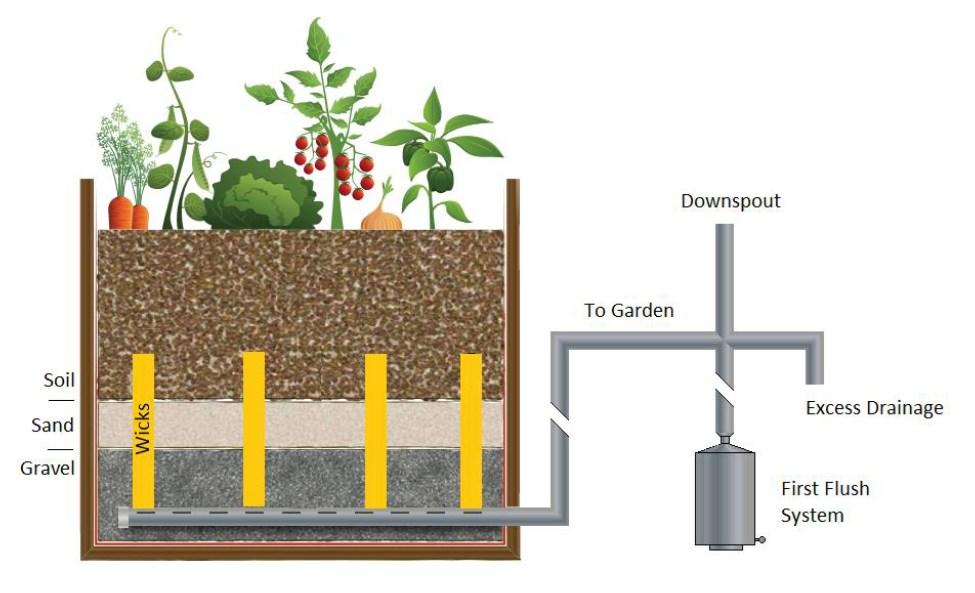
Rainwater Flow in the System
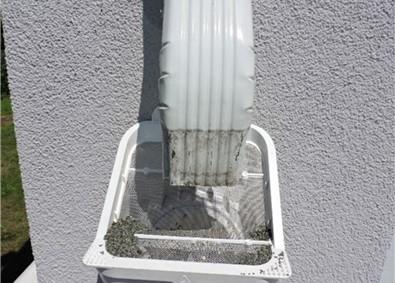
During a rain event, the rainwater travels from the roof to the pre-existing gutter and downspout. Researchers added the first-flush system to the gutter and downspout setup already on the building. As on most roofs, rainwater rolls into the gutter and down the spout. But instead of pouring onto the ground, the rainwater falls into the first-flush tank (Figure 1).
The rainwater then moves into a pipe covered with a mesh filter, to remove larger particles (Photo B). The first 35 gallons flow into a diversion tank containing a ball. Once the water level rises, the ball plugs the tank and the rest of the rainwater continues its journey toward the garden through a PVC pipe. The researchers also built in a small collection tube after the first-flush diversion to be able to test the water going into the beds (Photo C).
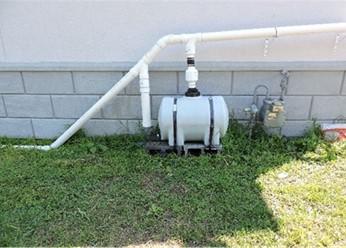
The irrigation system is designed to feed four beds. Due to the gently sloping decline, the rainwater flows on its own through the piping into all four beds (Photo D). The rainwater enters the raised beds through PVC pipes with drilled holes. The rainwater is wicked up into the bed, through the gravel layer, the sand layer, and then into the soil and roots layer, where it irrigates the produce.
During the garden’s first year, researchers grew Swiss chard in the beds connected to the subsurface irrigation system, which was not distributed for consumption (Photo E) due to concerns about water quality and safety.
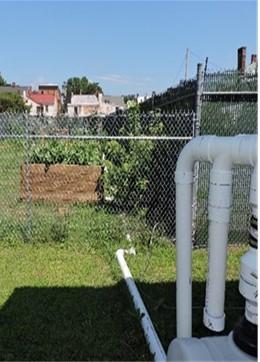
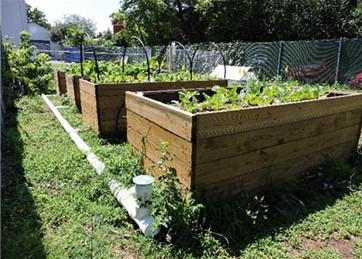
Funding and Implementation
According to Claire Hudson, a VRG Project manager and the program coordinator of the Coastal and Watershed Studies program at Hood College, a major challenge was finding the resources to build the raised beds. Multiple grants were awarded to the Hood College Frederick Food Security Network to support the installation and monitoring of the VRG beds at the Religious Coalition for Emergency Human Needs, including funding from the Frederick Rotary Club and the Mid Atlantic Campus Compact which supported an AmeriCorps Vista position (C. Hudson, personal communication, July 27, 2018).
In addition to securing funding, building the raised beds required a significant amount of labor and time. According to Catherine Dorsey, director of client services at the Religious Coalition for Emergency Human Needs Building, it took about 600 hours of volunteer time to build the garden. The volunteers included students from Hood College and clients of the Religious Coalition, including residents of the family shelter. One community member from the Religious Coalition had training as a carpenter and volunteered his time and expertise.
As Hudson noted, the VRG project “inspires people to get involved,” (C. Hudson, interview, July 2018). The community-oriented aspects of the project, such as fresh foods and potential to develop a sense of camaraderie, inspired the interest of community members, in a way that constructing stormwater mitigation system may not have.
Researchers Addressed Concerns about Water Quality through Safety Testing
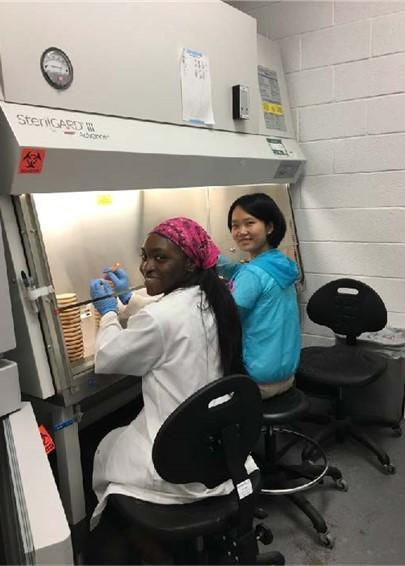
Few studies exist on harvested rooftop water quality. Some studies have raised concerns about contamination from heavy metals and bacteria on the roof and from environmental sources like birds and pollutants in rain. To address these concerns, the Hood College team partnered with researchers from the University of Maryland through the Center of Excellence at the Nexus of Sustainable Water Reuse, Food and Health (CONSERVE).
CONSERVE researchers evaluated water quality of ambient rainwater, first-flush rooftop runoff, water captured after the first flush, as well as bacterial concentrations in soil and the Swiss chard grown in the vegetable rain garden beds (Photo F). In rooftop rainwater systems, contaminants of concern include heavy metals including lead, copper, aluminum, cadmium, and zinc. These metals exist in the environment, are emitted from car exhausts, and can accumulate on building structures. Another potential contaminant in rainwater and rooftop runoff is microorganisms such as bacteria and pathogens (disease- causing organisms). The CONSERVE researchers tested water, soil, and produce for total coliforms, E. coli, and Enterococcus spp., three indicator bacteria that give an idea about the potential presence of pathogens. Testing for indicator bacteria is a rapid, reliable, and costeffective method to test for possible fecal contamination. The bacterial and heavy metal results are still being finalized and additional analyses are still being conducted.
Due to the potential water quality concerns, no produce from the subsurface irrigated beds was distributed to the community in 2018, but produce from the non-experimental beds was made available to the community for free during harvest season.
Garden Grows Community Benefits

After construction was completed, shelter residents maintained the beds, including planting, watering, and harvesting the produce. According to Dorsey, the surrounding community “has been really responsive…they are not just eating from the garden, they are participating in it… they want to help and they want to be involved.” (C. Dorsey, interview, October 2018).
Before the garden was built, the family shelter residents did not have regular access to fresh produce due to cost. The bounty of the garden provided new additions to their diets.
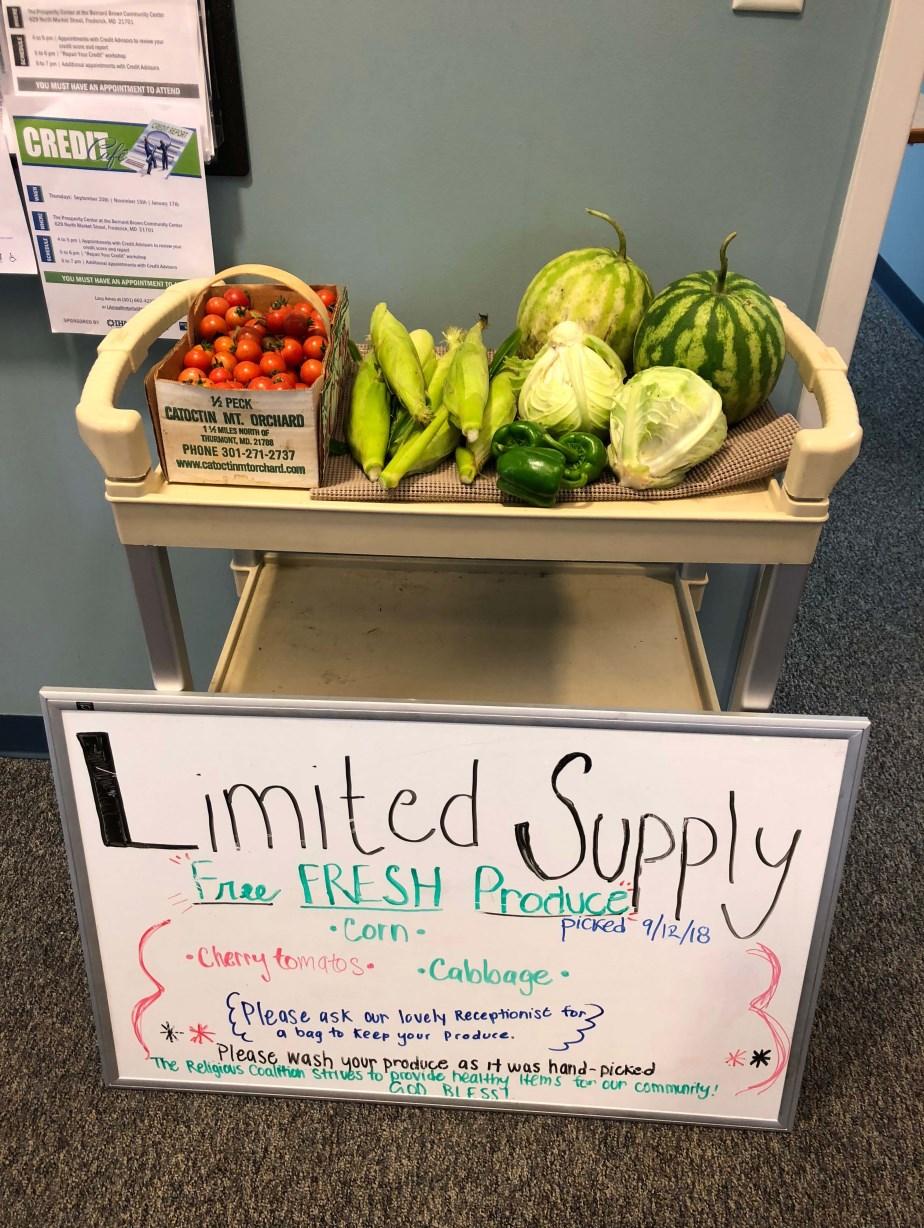
Dorsey and her team created recipe cards with nutritional information to help their clients find ways to cook the produce and understand the nutritional content (Figure 2). Dorsey shared a story about a resident who was excited to use cilantro from the garden to make guacamole and said “it was the best guacamole she ever had!” (C. Dorsey, interview, October 2018). The increased volunteer interest “shows the community is really on board with this garden” (C. Dorsey, interview, October 2018). By the end of the season, Dorsey estimates about 300 pounds of produce were harvested from the traditional garden beds and distributed to about 130 families in need. (Photo G). There was also enough produce to share with other family shelters and food banks in the area.
Though the produce from the VRG Project irrigated with rooftop runoff was not distributed to the community, the high level of engagement with the garden shows a desire for fresh produce. If the Hood College/CONSERVE study can demonstrate that the produce from the VRG Project is safe for people to eat, the VRG Project design will serve as a model for projects with multiple environmental and social benefits: protecting local waterways through reducing stormwater runoff and providing fresh produce to communities in need. As noted by Hudson, “the garden is for the community” (C. Hudson, personal communication, October 2018).
Lessons Learned and Future Research
After a full growing and harvest season of the VRG Project, the surrounding community remains excited about the vegetable garden. Member of the Religious Coalition and neighbors were interested in learning about the garden, the design, and the produce. This enthusiasm for a community project is part of what makes the VRG Project innovative. In addition to protecting the natural resources in the watershed, the people in the watershed are supported and feel connected to the project. Researchers did discover a problem with the raised beds. They were designed to retain the water to serve as a reservoir during dry periods, though trials showed this design did not retain water well. Some of the rainwater percolated into the ground instead of being wicked up into the beds. In the next trial, the raised beds will be fully lined.
Researchers will also continue to test the soil, produce, and water quality, including bacterial and heavy metal testing, and monitor soil moisture. The next series of VRGs has been expanded to three additional local sites: the Hood College campus, the Frederick Boys and Girls Club, and the Islamic Society of Frederick. The continued emphasis on choosing sites with an engaged, service-oriented community reflects the VRG Project goal of spreading the benefits of this system across environmental and social needs.
Final Thoughts
As communities use innovative projects to grapple with stressed water resources, it is important to consider how the potential solutions can also improve community wellbeing.
“One cause doesn’t help everybody, but if you combine causes, more people will be interested,” said Hudson. “Water is a precious resource…finding alternative [sources] for non- drinking water is a critical need with climate change right on our doorstep.” (C. Hudson, interview, July 2018).
References
- Egli, V., Oliver, M., & Tautolo, E. S. (2016). The development of a model of community garden benefits to wellbeing. Preventive medicine reports, 3, 348-352.
- Fragata, B. and Ferrier, D. An assessment of prototype components from vegetable rain gardens. Unpublished.
- Ntale, H. K., & Moses, N. 2003. Improving quality of harvested rainwater by using first flush interceptors/ retainers. In Proc. of 11th International Conference on Rainwater Catchment Systems, Texcoco, Mexico.
- Tom, M., Richards, P., McCarthy, D., Fletcher, T. D., Farrell, C., Williams, N., & Milenkovic, K. 2013. Turning (storm) water into food; the benefits and risks of vegetable raingardens. NOVATECH 2013.
- U.S. Department of Agriculture (USDA). Economic Research Service. Food Access Research Atlas: Documentation. Retrieved from: https://www.ers.usda.gov/data-products/food-access-research-atlas/ documentation. Last updated 5 December 2017.
Special thanks to:
- Catherine Dorsey, Religious Coalition for Emergency Human Services
- Claire Hudson and Drew Ferrier, Hood College Center for Coastal and Watershed Studies
- Nate Purser, Hood College
- Sam Watters, University of Maryland College of Agriculture and Natural Resources
- Xiaoxuan “Meg” Shi, Christine Nzokou, Quynh-Thu “Kaitlin” Ta, Nina Jeffries, Sarah Allard, Leena Malayil,
- CONSERVE, University of Maryland School of Public Health
MAYHAH SURI
msuri1@umd.edu
DR. RACHEL ROSENBERG GOLDSTEIN
rerosenb@umd.edu
This publication, Watering Seeds of Change with Rainwater (FS-1123), is part of a collection produced by the University of Maryland Extension within the College of Agriculture and Natural Resources.
The information presented has met UME peer-review standards, including internal and external technical review. For help accessing this or any UME publication contact: itaccessibility@umd.edu
For more information on this and other topics, visit the University of Maryland Extension website at extension.umd.edu
University programs, activities, and facilities are available to all without regard to race, color, sex, gender identity or expression, sexual orientation, marital status, age, national origin, political affiliation, physical or mental disability, religion, protected veteran status, genetic information, personal appearance, or any other legally protected class.



